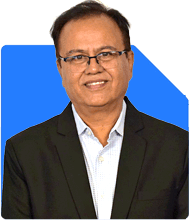55-Year-Old with 35 Lakhs in PF & PPF, Wants 50k Monthly Post-Retirement: How to Achieve?
Ramalingam Kalirajan |10906 Answers |Ask -Follow
Mutual Funds, Financial Planning Expert - Answered on Jul 26, 2024
He has an MBA in finance from the University of Madras and is a certified financial planner.
He is the director and chief financial planner at Holistic Investment, a Chennai-based firm that offers financial planning and wealth management advice.... more

Sir I m 55now I had 30 lacks in my provident fund and 5 lacks ppf and sip of 2 lacks 15000 sip per month salary is 1.10 lacks and having home loan car loan of 20 lacks I m retiring after 5 years I need 50000 per month for my expenses how it can be achieved please help me sir
Strategy for Retirement Planning
Clearing Debts
Home and Car Loan:
Aim to clear these loans before retirement.
Use bonuses, increments, or surplus funds to pay down the principal.
Maximizing Savings
Provident Fund:
Continue contributions to maximize retirement corpus.
Public Provident Fund (PPF):
PPF is a safe investment with tax benefits.
Consider increasing contributions if possible.
Systematic Investment Plans (SIPs):
Maintain or increase SIPs in mutual funds.
Choose funds with good track records for growth.
Investment Options for Retirement
Debt Mutual Funds
Safety and Regular Income:
Invest in debt mutual funds for steady returns.
Ideal for generating regular income with low risk.
Balanced Mutual Funds
Mix of Equity and Debt:
These funds offer growth with moderate risk.
Good for long-term investments and stable returns.
Creating a Retirement Corpus
Monthly Savings and Investments
Consistent Investing:
Save and invest a portion of your monthly salary.
Focus on increasing your retirement corpus.
Diversified Portfolio
Balance Risk and Return:
Diversify your investments across various asset classes.
Include a mix of equity, debt, and balanced funds.
Generating Post-Retirement Income
Systematic Withdrawal Plan (SWP)
Regular Income:
Use SWPs from mutual funds for monthly income.
This provides a fixed amount regularly without depleting capital too quickly.
Monthly Income Plans (MIPs)
Steady Cash Flow:
Invest in MIPs for regular payouts.
These are suitable for generating a steady cash flow post-retirement.
Insurance and Health Cover
Adequate Coverage
Review Insurance:
Ensure your insurance coverage is adequate.
Personal insurance should cover major health expenses.
Health Insurance
Medical Expenses:
Maintain a comprehensive health insurance plan.
It will help manage medical costs post-retirement.
Final Insights
Clear Loans: Aim to pay off your home and car loans before retiring.
Increase Savings: Continue and increase your contributions to provident fund, PPF, and SIPs.
Diversify Investments: Invest in a mix of debt and balanced mutual funds.
Generate Income: Use SWPs and MIPs to generate a steady post-retirement income.
Review Insurance: Ensure you have adequate insurance coverage for unforeseen expenses.
Best Regards,
K. Ramalingam, MBA, CFP,
Chief Financial Planner,
www.holisticinvestment.in
You may like to see similar questions and answers below
Sunil Lala | Answer |Ask -Follow
Financial Planner - Answered on Feb 26, 2024
Ramalingam Kalirajan |10906 Answers |Ask -Follow
Mutual Funds, Financial Planning Expert - Answered on May 16, 2024
Ramalingam Kalirajan |10906 Answers |Ask -Follow
Mutual Funds, Financial Planning Expert - Answered on Jul 26, 2024
Ramalingam Kalirajan |10906 Answers |Ask -Follow
Mutual Funds, Financial Planning Expert - Answered on Feb 06, 2025
Ramalingam Kalirajan |10906 Answers |Ask -Follow
Mutual Funds, Financial Planning Expert - Answered on Aug 02, 2025
Ramalingam Kalirajan |10906 Answers |Ask -Follow
Mutual Funds, Financial Planning Expert - Answered on Dec 19, 2025
Nayagam P P |10859 Answers |Ask -Follow
Career Counsellor - Answered on Dec 19, 2025
Ramalingam Kalirajan |10906 Answers |Ask -Follow
Mutual Funds, Financial Planning Expert - Answered on Dec 19, 2025
Ramalingam Kalirajan |10906 Answers |Ask -Follow
Mutual Funds, Financial Planning Expert - Answered on Dec 19, 2025
Ramalingam Kalirajan |10906 Answers |Ask -Follow
Mutual Funds, Financial Planning Expert - Answered on Dec 19, 2025
Radheshyam Zanwar |6751 Answers |Ask -Follow
MHT-CET, IIT-JEE, NEET-UG Expert - Answered on Dec 19, 2025
Radheshyam Zanwar |6751 Answers |Ask -Follow
MHT-CET, IIT-JEE, NEET-UG Expert - Answered on Dec 19, 2025
Samraat Jadhav |2514 Answers |Ask -Follow
Stock Market Expert - Answered on Dec 18, 2025
Reetika Sharma |432 Answers |Ask -Follow
Financial Planner, MF and Insurance Expert - Answered on Dec 18, 2025
Reetika Sharma |432 Answers |Ask -Follow
Financial Planner, MF and Insurance Expert - Answered on Dec 18, 2025
























